Threat Group Assessment: Turla (aka Pensive Ursa)

Executive Summary
Turla (aka Pensive Ursa, Uroburos, Snake) is a Russian-based threat group operating since at least 2004, which is linked to the Russian Federal Security Service (FSB). In this article, we will cover the top 10 most recently active types of malware in Pensive Ursa’s arsenal: Capibar, Kazuar, Snake, Kopiluwak, QUIETCANARY/Tunnus, Crutch, ComRAT, Carbon, HyperStack and TinyTurla.
Pensive Ursa was chosen to be the main focus for the 2023 MITRE ATT&CK evaluation. MITRE has described Turla as being “known for their targeted intrusions and innovative stealth.” The results of this evaluation, including Palo Alto Networks scoring, will be published in late September 2023.
In addition to describing each type of malware’s functionality and history, we will present their execution through the lens of the Palo Alto Networks Cortex XDR product. We will show how Cortex protects against such malware, and the MITRE ATT&CK mapping of such threats as shown in the Cortex XDR platform.
Palo Alto Networks customers receive protections from Pensive Ursa’s arsenal and the techniques discussed in this blog through Cortex XDR, which provides a multilayer defense that includes behavioral threat protection and exploit protection.
The Advanced WildFire cloud-delivered malware analysis service accurately identifies samples related to Pensive Ursa as malicious. Cloud-Delivered Security Services, including Advanced URL Filtering and DNS Security, identify domains associated with this group as malicious.
| Related Unit 42 Topics | APT, Malware |
| Pensive Ursa | Alternative names: Turla, Snake, Uroburos, Venomous Bear, Waterbug, Iron Hunter |
| Malware discussed | Capibar, Kazuar, Snake, QUIETCANARY, Kopiluwak, Crutch, ComRAT, Carbon, HyperStack, TinyTurla |
Table of Contents
Executive Summary
Table of Contents
Pensive Ursa (aka Turla) Overview
Recent Pensive Ursa Arsenal Technical Analysis
Malware: Capibar
Malware: Kazuar
Malware: Snake
Malware: QUIETCANARY
Malware: Kopiluwak
Malware: Crutch
Malware: ComRAT
Malware: Carbon
Malware: HyperStack
Malware: TinyTurla
Tactics, Techniques and Procedures (TTPs)
Conclusion
Protections and Mitigations
Indicators of Compromise (IoCs)
Additional References
Pensive Ursa (aka Turla) Overview
Over the years, Pensive Ursa has become known as an advanced and elusive adversary. The group has demonstrated a high level of technical expertise, while orchestrating targeted and stealthy attacks.
As described by MITRE, Pensive Ursa targeted victims in over 45 countries as well as a wide range of sectors, including government entities, embassies, and military organizations, as well as education, research and pharmaceutical companies. In addition, this threat group had an active part in the Russian-Ukraine conflict that started in February 2022. According to the Ukraine CERT, Pensive Ursa leveraged espionage attacks against Ukrainian targets, specifically against their defense sector.
While Pensive Ursa mainly used their espionage arsenal to target Windows machines, the group also has tools that can attack macOS and Linux machines.
MITRE ATT&CK Evaluation
For the 2023 MITRE ATT&CK evaluation, Pensive Ursa was chosen to be the main focus. According to MITRE, this threat group is particularly relevant as their actions have global impact.
Below are the top 10 most recently active types of malware in the team’s arsenal. For each type of malware, we provided a short description and analysis, as well as how Cortex XDR detects and prevents the threat.
Recent Pensive Ursa Arsenal Technical Analysis
Malware: Capibar
Aliases: DeliveryCheck, GAMEDAY
Malware Type: Backdoor
First Seen: 2022
Description: Capibar (aka DeliveryCheck, GAMEDAY) is a Pensive Ursa backdoor that was first observed in 2022, and used for the purpose of espionage against defense forces in Ukraine. They distributed it via email as documents with malicious macros.
Capibar persists via a scheduled task that downloads and launches the payload in memory. The threat group installed Capibar on compromised MS Exchange servers as a Managed Object Format (MOF) file, granting the attacker full control of the server. Figure 1a below shows a snippet of the code responsible for loading XML received from its command and control (C2), and Figure 1b shows the alert triggered.
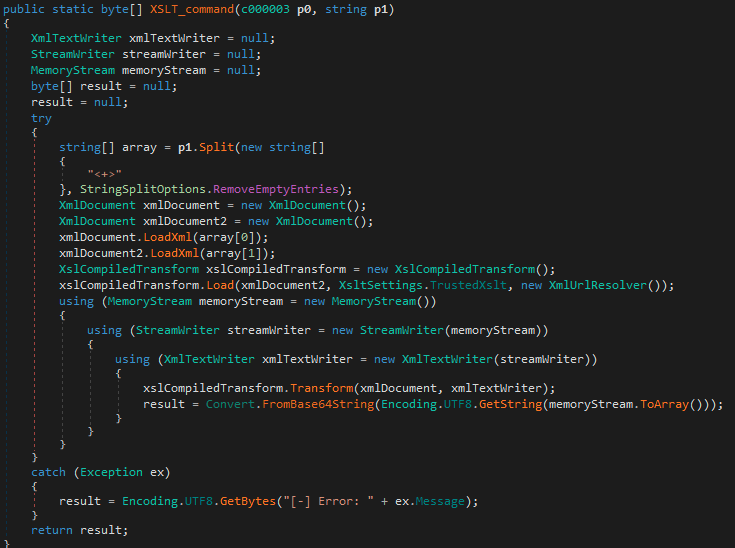

Malware: Kazuar
Malware Type: Backdoor
First Seen: 2017
Description: Kazuar is a .NET backdoor that was discovered in 2017. Kazuar provides full access to the compromised systems targeted by its operator. Kazuar comes with a powerful command set that includes the ability to remotely load additional plugins to enhance the backdoor’s capabilities.
In 2021, researchers found interesting code overlaps and similarities between Kazuar and the notorious SUNBURST backdoor that a Russian threat group used in the SolarWinds Operation. In July 2023, the Ukrainian CERT uncovered an espionage operation where Pensive Ursa used Kazuar as one of the main backdoors. Figure 2 shows Cortex XDR preventing a Kazuar DLL from being injected into the explorer.exe process, and Figure 3 shows an alert being triggered for Kazuar prevention.
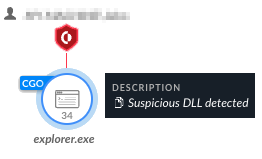
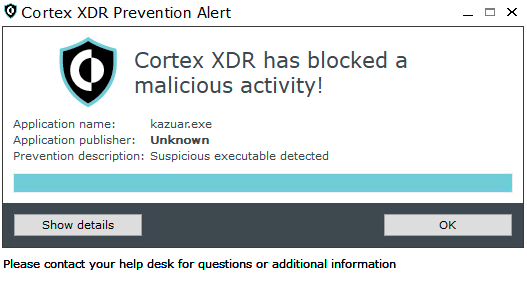
Malware: Snake
Malware Type: Modular backdoor
First Seen: 2003
Description: The infamous Snake malware is the most complex tool in Pensive Ursa’s tool set, as described by CISA in May 2023. The primary purpose of this tool is to achieve persistence for considerable periods of time and exfiltrate data from dedicated targets. It was in active development for 20 years, since 2003.
Snake was detected operating in more than 50 countries worldwide. The United States Department of Justice published a statement in which they announced Operation MEDUSA, where they disrupted the Snake malware activity and peer to peer (P2P) network. They did so by using a tool developed by the FBI dubbed PERSEUS, which they used as a kill switch for the Snake malware.
Based on previous analysis, the Snake malware implemented a maintainable code design, which showed that its authors had a high level of software development capability.
Snake implements features such as the following:
- A custom implementation of communication protocols over HTTP and TCP
- A kernel module for stealth
- Key logger functionality
More recent variants of Snake include an infection chain similar to the one depicted below.
Example of Snake Malware Delivery
Upon execution, Snake loads and executes Pensive Ursa’s PNG Dropper malware from its resources and creates a hard-coded mutex {E9B1E207-B513-4cfc-86BE-6D6004E5CB9C, as shown in Figure 4.
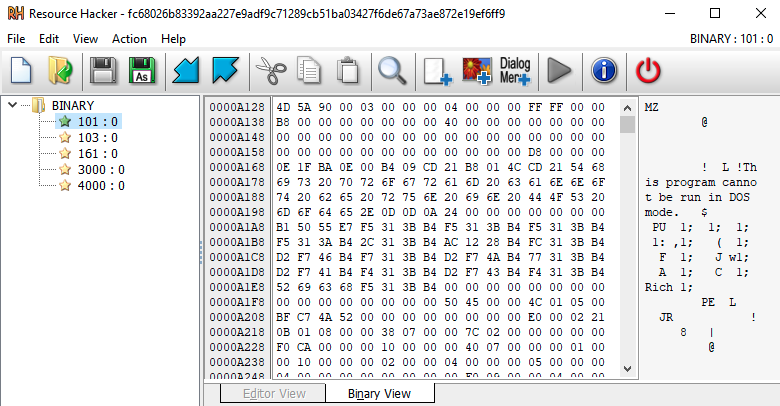
The PNG dropper then decodes and loads a vulnerable VM driver that is used for privilege escalation in order to write the main Snake payload to disk, and register it as a service.
The Snake loader variant shown in Figure 5 detects the multiple stages in the infection chain that lead to the deployment, service registration and execution of the main Snake payload. Figure 6 shows the execution prevention alert pop-up in Cortex XDR.
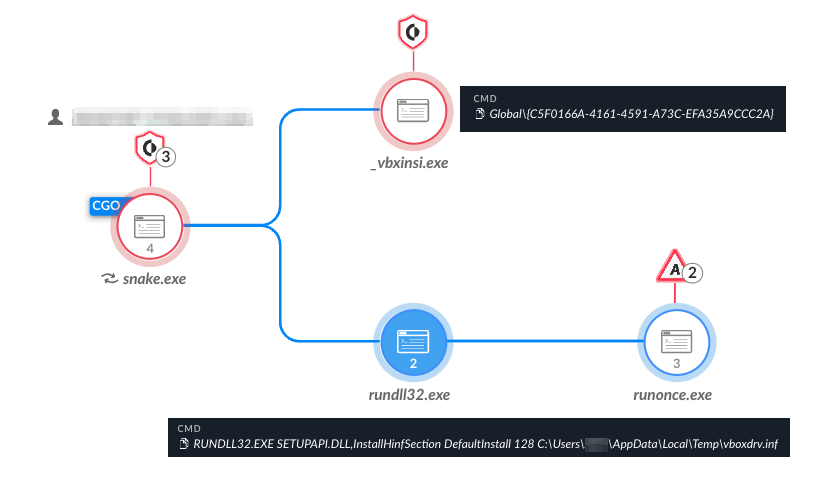
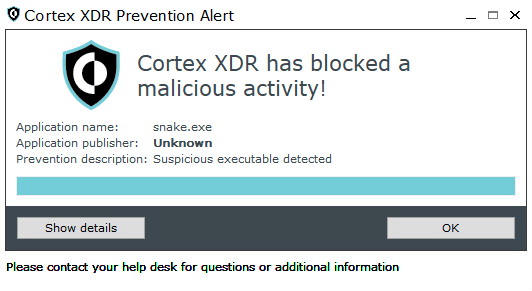
Malware: QUIETCANARY
Aliases: Tunnus
Malware Type: Backdoor
First Seen: 2017
Description: Pensive Ursa has been observed using QUIETCANARY since 2019, and the Tomiris group has used this backdoor even earlier. Pensive Ursa deployed QUIETCANARY against targets in Ukraine in September 2022, together with the Kopiluwak malware. QUIETCANARY is a lightweight backdoor written in .NET, which is capable of executing various commands received from its C2 server, including downloading additional payloads and executing arbitrary commands. It also implements RC4 encryption to protect its C2 communication. Figure 7 shows QUIETCANARY’s different classes that reveal its backdoor capabilities.
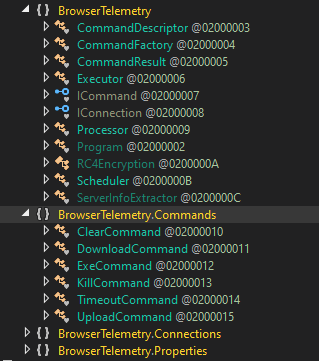
Figure 8 shows the Cortex XDR multilayered protection-based alerts that QUIETCANARY triggered. Figure 9 shows the execution prevention alert.

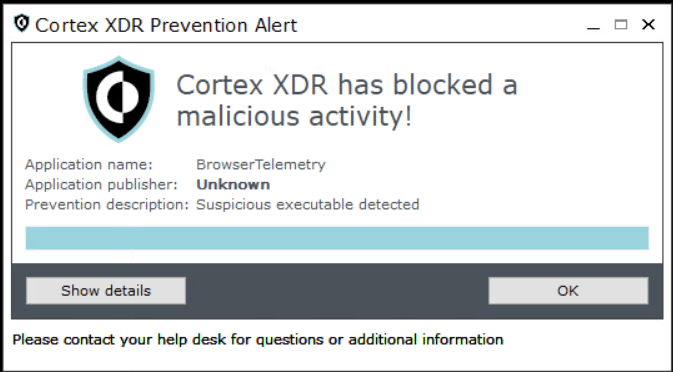
Malware: Kopiluwak
Malware Type: Spreader/Downloader
First Seen: 2016
Description: Kopiluwak malware was discovered in late 2016, and it was delivered as a multilayered JavaScript payload by various types of droppers.
Pensive Ursa dropped the Kopiluwak malware using an MSIL dropper in 2017 in a G20-themed attack, and as an SFX executable in late 2022.
Kopiluwak’s JavaScript file is depicted in Figure 10 and the code snippet below, dropped under the C:WindowsTemp path. Its purpose is gathering valuable initial profiling information on the infected machine, such as the following:
- Listing files in strategic locations
- Retrieving the current running processes
- Displaying active network connections
The threat actor accomplished this activity by running reconnaissance commands such as systeminfo, tasklist, net, ipconfig, and dir. The results are saved in a file named result2.dat.
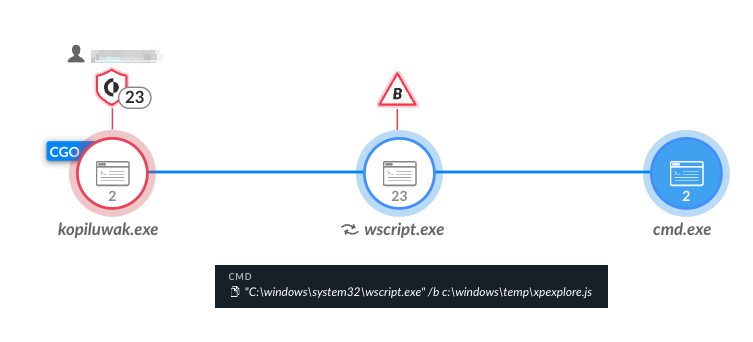
Listed in Figure 11 are the reconnaissance commands executed by Kopiluwak, and detected by Cortex XDR.
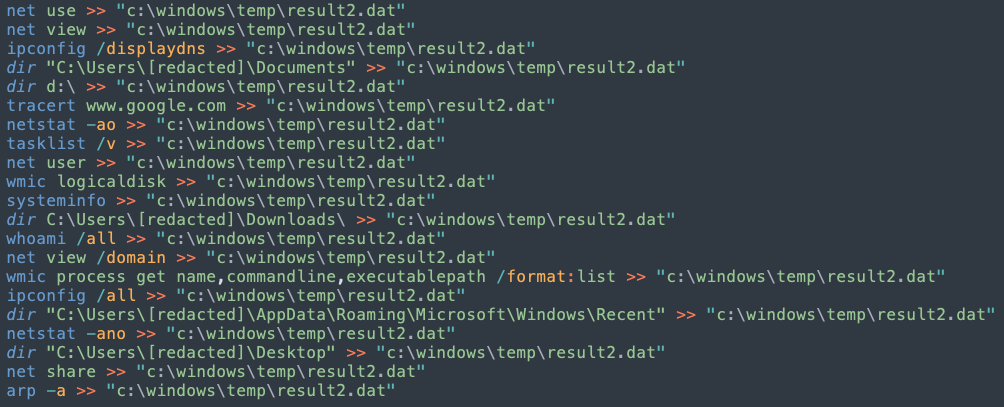
Figure 12 shows Cortex XDR raising an execution prevention alert for Kopiluwak.
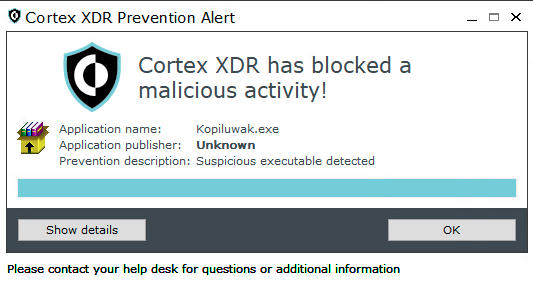
In 2019, Pensive Ursa began to deliver Kopiluwak using the Topinambour dropper. The group bundled Topinambour into a legitimate software installer.
Upon installation, Topinambour is dropped as a small .NET file in the %localappdata% folder and written as a scheduled task, as shown in Figure 13. The malware then communicates with its hard-coded C2 virtual private server (VPS) to deliver the Kopiluwak malware.
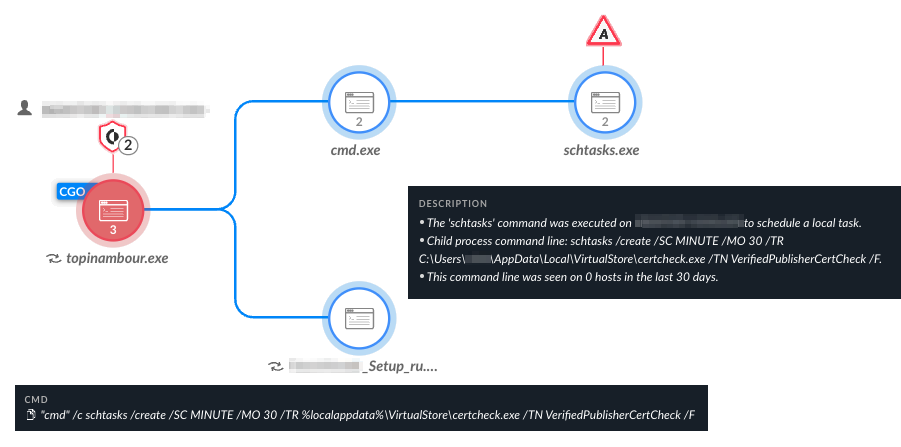
Figure 14 shows the prevention alert pop-up raised by Cortex XDR.
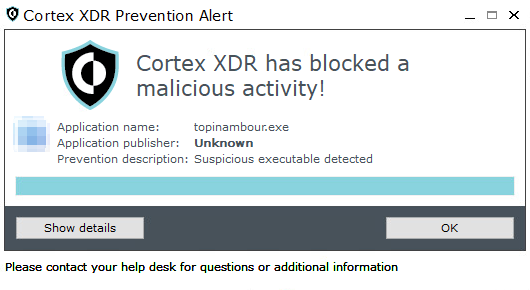
Malware: Crutch
Malware Type: Backdoor
First Seen: 2015
Description: In December 2020, ESET researchers discovered the Crutch backdoor. In line with Pensive Ursa’s tactics, techniques and procedures (TTPs), the threat actor used the backdoor to attack a handful of targets in Europe, including the Ministry of Foreign Affairs of an EU member.
The main purpose of this backdoor was to eventually steal sensitive files and exfiltrate the data to a Dropbox account controlled by Pensive Ursa operators. Using commercial services such as Dropbox for C2 communication is a known (yet effective) technique due to it being a legitimate service, and blending in with other network communication.
This backdoor was attributed to Pensive Ursa due to strong similarities in code and TTPs with another backdoor from Pensive Ursa’s arsenal called Gazer. Crutch is considered to be a second-stage backdoor, and its persistence is achieved using DLL hijacking.
Figures 15 and 16 show the detection and prevention of Crutch respectively, in Cortex XDR.
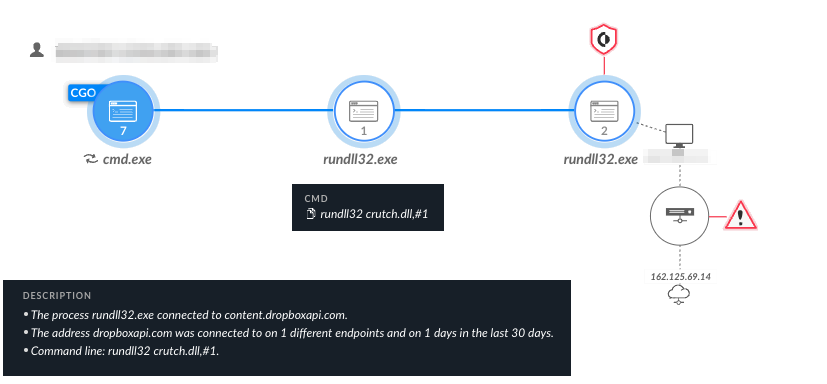
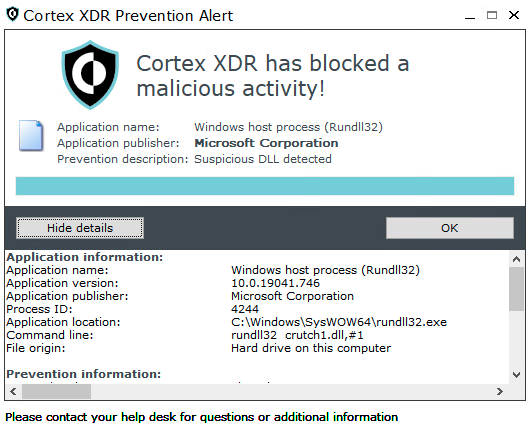
Malware: ComRAT
Aliases: Agent.btz
Malware Type: Backdoor
First Seen: 2007
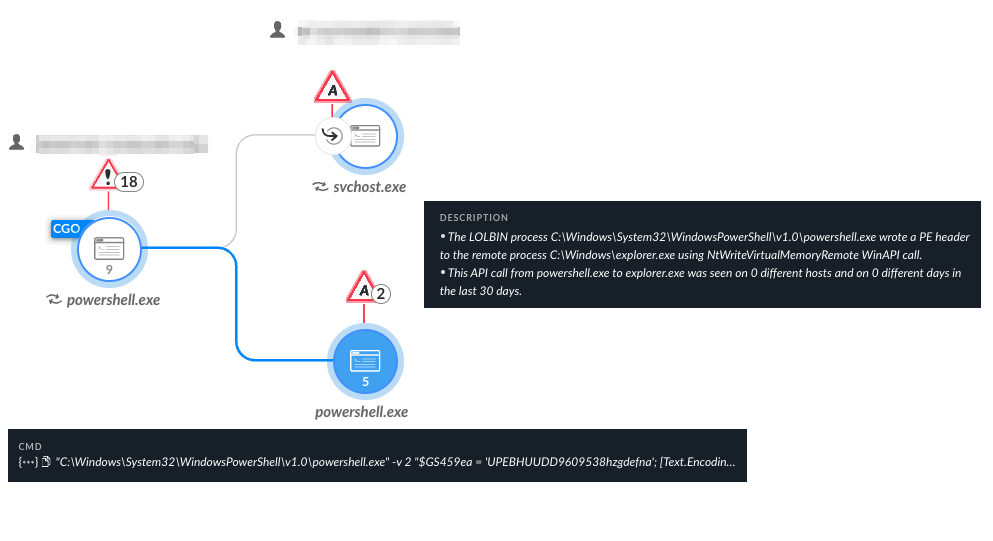
Description: ComRAT is one of Pensive Ursa’s oldest backdoors, which they named Agent.btz in earlier iterations of the malware. ComRAT was reportedly first discovered in 2007. Since then it has had many upgrades. As of 2020, the latest iteration of ComRAT is version 4. This threat is developed in C++ and the threat actor has deployed it using PowerShell implants, such as PowerStallion. Figure 17 shows the PowerShell dropper mechanism. The threat actor’s main purpose of operations when using ComRAT was to steal and exfiltrate confidential documents from high value targets.

Figures 18a and 18b depict the PowerShell and DLL executions preventions respectively, in Cortex XDR.

Malware: Carbon
Malware Type: Backdoor
First Seen: 2014
Description: Carbon is a modular backdoor framework that has been used by Pensive Ursa for several years. The Carbon framework includes an installer, an orchestrator component, a communication module and a configuration file.
Carbon also has P2P communication capabilities, which the threat actor uses to send commands to other infected machines on an affected network. Carbon receives commands from the C2 through the use of legitimate web services providers like Pastebin.
Figure 19 and Figure 20 show Carbon’s execution detection and prevention in Cortex XDR.

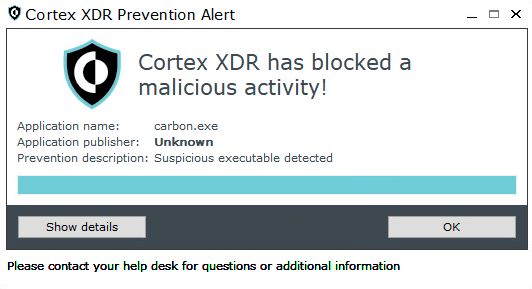
Malware: HyperStack
Malware Type: Backdoor
First Seen: 2018
Description: HyperStack (aka SilentMoo, BigBoss) is an RPC backdoor that was first observed in 2018, which the threat actor used in operations targeting government entities in Europe. HyperStack operates with a controller that uses named pipes to communicate over RPC with other machines in a compromised environment that are infected with HyperStack. This communication method enables the attacker to control machines on a local network.
HyperStack shows several similarities with Pensive Ursa’s Carbon backdoor, such as the encryption scheme, configuration file format and logging convention.
Figure 21 and Figure 22 show HyperStack’s detection and prevention respectively, in Cortex XDR.

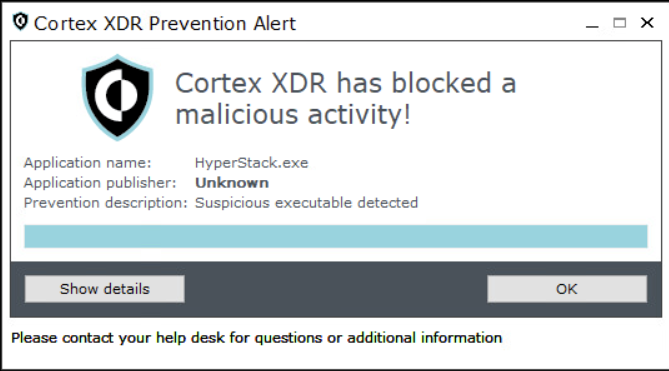
Malware: TinyTurla
Malware Type: Backdoor
First Seen: 2021
Description: The TinyTurla malware was first discovered by Talos in 2021. They assumed it was a second stage backdoor, and it has been seen on targets in the US, EU and later in Asia.
TinyTurla’s main features include the following:
- Downloading additional payloads
- Uploading files to the attacker’s C2 server
- Executing other processes
As shown in Figure 23, threat actors install the backdoor via a batch script as a service called Windows Time Service. The batch script is also in charge of writing the C2 server’s data to the registry. Once the backdoor is executed, it reads these values to communicate with its C2. It masquerades as a DLL called w64time.dll, under the system32 folder.

Although w32time.dll is a legitimate DLL, and other legitimate DLLs do have both 32- and 64-bit variants, a legitimate w64time.dll does not exist. This naming convention is intended to further distract victims from suspecting anything is amiss.
Figure 24 and Figure 25 show Cortex XDR detecting the writing and execution of the batch script, the W64Time service and the TinyTurla DLL execution.

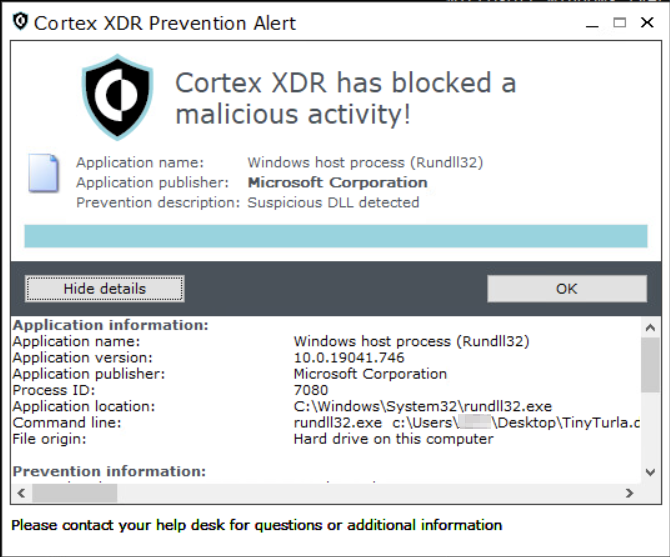
Tactics, Techniques and Procedures (TTPs)
Cortex XDR alerts are mapped to the MITRE ATT&CK framework and present information about the tactic and the technique associated with the threat, as shown in Figure 26 below.

Pensive Ursa-related activities and arsenal raised multiple alerts in Cortex XDR, which were mapped to the MITRE ATT&CK tactics and techniques referenced in Table 1.
Table 1. MITRE ATT&CK tactics and techniques.
Conclusion
The Pensive Ursa advanced persistent threat (APT) group is known to be a significant and persistent adversary. With their advanced techniques, this Russian-FSB operated group has demonstrated an evasive modus operandi while targeting a wide range of sectors across the globe.
We explored the top 10 types of malware in Pensive Ursa’s arsenal and witnessed their execution through the lens of Palo Alto Networks Cortex XDR product. This demonstrated the importance of using a multilayered protection model against an advanced threat.
The potential damage of falling victim to a Pensive Ursa APT attack can be significant. The consequences extend beyond financial losses and data breaches to the possibility of them reaching critical infrastructure, which could have national security and geopolitical ramifications. Thus, every organization, regardless of its size or industry, must prioritize comprehensive security strategies and invest in multilayer security measurements to safeguard against the growing threat of APT groups like Pensive Ursa.
Protections and Mitigations
Palo Alto Networks Cortex XDR and XSIAM customers receive protections against Pensive Ursa’s arsenal of malware described in this blog post.
Prevention and detection alerts were raised for each malware: Capibar, Kazua, Snake, Kopiluwak, QUIETCANARY/Tunnus, Crutch, ComRAT, Carbon, HyperStack and TinyTurla.
SmartScore is a unique ML-driven scoring engine that translates security investigation methods and their associated data into a hybrid scoring system. It scored an incident involving a combination of known Pensive Ursa tools and techniques a 91 score, which is a very high level of risk, as shown below in Figure 26.
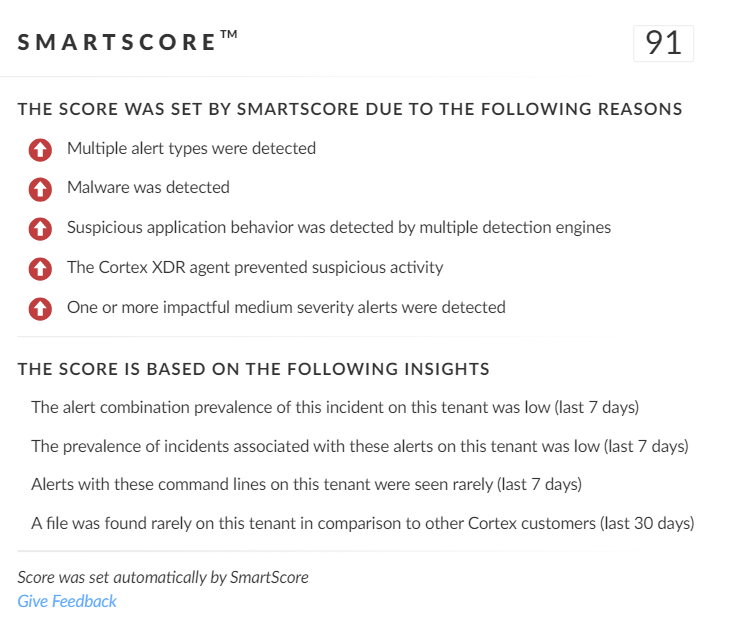
For Palo Alto Networks customers, our products and services provide the following coverage associated with this group:
Cortex XDR detects user and credential-based threats by analyzing user activity from multiple data sources including the following:
- Endpoints
- Network firewalls
- Active Directory
- Identity and access management solutions
- Cloud workloads
Cortex XDR builds behavioral profiles of user activity over time with machine learning. By comparing new activity to past activity, peer activity and the expected behavior of the entity, Cortex XDR detects anomalous activity indicative of credential-based attacks.
It also offers the following protections related to the attacks discussed in this post:
- Prevents the execution of known malicious malware and also prevents the execution of unknown malware using Behavioral Threat Protection and machine learning based on the Local Analysis module
- Protects against credential gathering tools and techniques using the new Credential Gathering Protection available from Cortex XDR 3.4
- Protects from threat actors dropping and executing commands from web shells using Anti-Webshell Protection, newly released in Cortex XDR 3.4
- Protects against exploitation of different vulnerabilities including ProxyShell and ProxyLogon using the Anti-Exploitation modules as well as Behavioral Threat Protection
- Cortex XDR Pro detects post-exploit activity, including credential-based attacks, with behavioral analytics
If you think you might have been impacted or have an urgent matter, get in touch with the Unit 42 Incident Response team or call:
North America Toll-Free: 866.486.4842 (866.4.UNIT42)
- EMEA: +31.20.299.3130
- APAC: +65.6983.8730
- Japan: +81.50.1790.0200
Palo Alto Networks has shared these findings, including file samples and indicators of compromise, with our fellow Cyber Threat Alliance (CTA) members. CTA members use this intelligence to rapidly deploy protections to their customers and to systematically disrupt malicious cyber actors. Learn more about the Cyber Threat Alliance.
Indicators of Compromise
Capibar
Hashes (SHA-256):
- ba2c8df04bcba5c3cfd343a59d8b59b76779e6c27eb27b7ac73ded97e08f0f39
- 64e8744b39e15b76311733014327311acd77330f8a135132f020eac78199ac8a
Domains:
- hxxps://mail.numina[.]md/owa/scripts/logon.aspx
- hxxps://mail.aet.in[.]ua/outlook/api/logoff.aspx
- hxxps://mail.arlingtonhousing[.]us/outlook/api/logoff.aspx
- hxxps://mail.kzp[.]bg/outlook/api/logoff.aspx
- hxxps://mail.lechateaudelatour[.]fr/MICROSOFT.EXCHANGE.MAILBOXREPLICATIONSERVICE.PROXYSERVICE/RPCWITCHERT/SYNC
- hxxps://mail.lebsack[.]de/MICROSOFT.EXCHANGE.MAILBOXREPLICATIONSERVICE.PROXYSERVICE/RPCWITCHERT/SYNC
Kazuar
Hashes (SHA-256):
- 8490daab736aa638b500b27c962a8250bbb8615ae1c68ef77494875ac9d2ada2
- b51105c56d1bf8f98b7e924aa5caded8322d037745a128781fa0bc23841d1e70
- Bf6f30673cf771d52d589865675a293dc5c3668a956d0c2fc0d9403424d429b2
- cd4c2e85213c96f79ddda564242efec3b970eded8c59f1f6f4d9a420eb8f1858
Domains:
- Gaismustudija[.]lv
- Hcdh-tunisie[.]org
- www.gallen[.]fi
- hxxps://www.bombheros[.]com/wp-content/languages/index[.]php
- hxxps://www.simplifiedhomesales[.]com/wp-includes/images/index.php
- hxxp://mtsoft.hol[.]es/wp-content/gallery/
- hxxp://www.polishpod101[.]com/forum/language/en/sign/
- hxxps://www.pierreagencement[.]fr/wp-content/languages/index.php
- hxxps://sansaispa[.]com/wp-includes/images/gallery/
- hxxps://octoberoctopus.co[.]za/wp-includes/sitemaps/web/
Snake
Hashes (SHA-256):
- fc68026b83392aa227e9adf9c71289cb51ba03427f6de67a73ae872e19ef6ff9
- 1950d2e706fbc6263d376c0c4f16bd5acfd543248ee072657ba3dd62da8427eb
- cf3a7d4285d65bf8688215407bce1b51d7c6b22497f09021f0fce31cbeb78986
- b262292e049ee75d235164df98fa8ed09a9e2a30c5432623856bafd4bd44d801
Kopiluwak
Hashes (SHA-256):
- 6536b6b50aa1f6899ffa90aaf4b1b67c0ae0f6c0441016f5308b37c12141c61d
- 8d9bb878a18b2b7ef558504e78a59eb644f83a63679658533ff8accf0b85fda3
Domains:
- manager.surro[.]am
IPs:
- 194.67.209[.]186
Topinambour
Hashes (SHA-256):
- 009406c1c7c0b289a25d44dfaa8364633d9b71df5f3c7a65deec1ef00a8c2ebb
- 7a7d11adbcb740323eb52b097f535cfa5c281bf07a4d5c4afb0c5182fa4ffd1b
- d4ba16db7c26622d2d402cb9714331abfee891b6276d16e6c2f2132e8944cc71
- 046f11a6c561e46e6bf199ab7f50e74a4d2aaead68cdbd6ce44b37b5b4964758
IPs:
- 197.168.0[.]247
QUIETCANARY/Tunnus
Hashes (SHA-256):
- 0fc624aa9656a8bc21731bfc47fd7780da38a7e8ad7baf1529ccd70a5bb07852
- 3f94b20cb7f4ff55207660649ebbb02679c991fe03efbcb0bd3840fc7f0bd527
- 29314f3cd73b81eda7bd90c66f659235e6bb900e499c9cc7057d10a9083a0b94
- 87663affd147065d08d4fe76d9a18b0d7d85fab68cf9f5ac96cfdfff3f27ffd2
Domains:
- lakihelppi[.]com
IPs:
- 46.101.209[.]249
- 210.48.231[.]182
Crutch
Hashes (SHA-256):
- 0010ccb822538d1881c61be874af49382c44b6c9cb665081cf0f672cbed5b6a5
- 29b1da7b17a7ba3e730e6927058d0554a8bc81bdef88e364097fab0bb1950edc
- 16860fc685ea0dee91e65e253062153ac6c886fdd73a3020c266601f58038a61
- 10c0e2afb37a24ac7732a402a4c9d854b35a382f1651d4aa2ece429b154aecb2
ComRAT
Hashes (SHA-256):
- 00352afc7e7863530e4d68be35ae8b60261fc57560167645697b7bfc0ac0e93d
- 134919151466c9292bdcb7c24c32c841a5183d880072b0ad5e8b3a3a830afef8
- 166b1fb3d34b32f1807c710aaa435d181aedbded1e7b4539ffa931c2b2cdd405
- 44d6d67b5328a4d73f72d8a0f9d39fe4bb6539609f90f169483936a8b3b88316
- A3170c32c09fc85cdda778a5c20a3dab144b6d1dd9996ba8340866e0081c7642
- 187bf95439da038c1bc291619507ff5e426d250709fa5e3eda7fda99e1c9854c
- b93484683014aca8e909c9b5648d8f0ac21a45d0c193f6ca40f0b01d2464c1c4
Domains:
- branter[.]tk
- wekanda[.]tk
- sanitar[.]ml
- duke6[.]tk
- bronerg[.]tk
- Crusider[.]tk
Carbon
Hashes (SHA-256):
- 493e5fae191950b901764868b065ddddffa4f4c9b497022ee2f998b4a94f0fc2
- f3aaa091fdbc8772fb7bd3a81665f4d33c3b62bf98caad6fee4424654ba26429
- 2b969111dd1968d47b02d6390c92fb622cd03570b02ecf9215031ff03611a2b7
- 7d5794ad91351c7c5d7fbad8e83e3b71a09baac65fb09ca75d8d18339d24a46f
Domains:
- www.berlinguas[.]com
- www.balletmaniacs[.]com
HyperStack
Hashes (SHA-256):
- 6ca0b4efe077fe05b2ae871bf50133c706c7090a54d2c3536a6c86ff454caa9a
- 20691ff3c9474cfd7bf6fa3f8720eb7326e6f87f64a1f190861589c1e7397fa5
- e33580ae3df9d27d7cfb7b8f518a2704e55c92dd74cbbab8ef58ddfd36524cc8
TinyTurla
Hashes (SHA-256):
- 030cbd1a51f8583ccfc3fa38a28a5550dc1c84c05d6c0f5eb887d13dedf1da01
Get updates from
Palo Alto
Networks!
Sign up to receive the latest news, cyber threat intelligence and research from us

